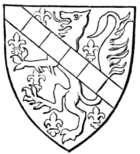because in the latter case each spear is placed fesswise, but the three occupy in relation to each other the position of a pale. Three tilting-spears fesswise which were not in pale would be depicted 2 and 1.
When one charge surmounts another, the undermost one is mentioned first, as in the arms of Beaumont (see Fig. 62). Here the lion rampant is the principal charge, and the bend which debruises it is consequently mentioned afterwards.
In the cases of a cross and of a saltire, the charges when all are alike would simply be described as between four objects, though the term "cantonned by" four objects is sometimes met with. If the objects are not the same, they must be specified as being in the 1st, 2nd, or 3rd quarters, if the ordinary be a cross. If it be a saltire, it will be found that in Scotland the charges are mentioned as being in chief and base, and in the "flanks." In England they would be described as being in pale and in fess if the alternative charges are the same; if not, they would be described as in chief, on the dexter side, on the sinister side, and in base.

Fig. 62.—Arms of John de Beaumont, Lord Beaumont (d. 1369): Azure, semé-de-lis and a lion rampant or, over all a bend gobony argent and gules. (From his seal.)
When a specified number of charges is immediately followed by the same number of charges elsewhere disposed, the number is not repeated, the words "as many" being substituted instead. Thus: "Argent, on a chevron between three roses gules, as many crescents of the field." When any charge, ordinary, or mark of cadency surmounts a single object, that object is termed "debruised" by that ordinary. If it surmounts everything, as, for instance, "a bendlet sinister," this would be termed "over all." When a coat of arms is "party" coloured in its field and the charges are alternately of the same colours transposed, the term counterchanged is used. For example, "Party per pale argent and sable, three chevronels between as many mullets pierced all counterchanged." In that case the coat is divided down the middle, the dexter field being argent, and the sinister sable; the charges on the sable being argent, whilst the charges on the argent are sable. A mark of cadency is mentioned last, and is termed "for difference"; a mark of bastardy, or a mark denoting lack of blood descent, is termed "for distinction."
Certain practical hints, which, however, can hardly be termed rules, were suggested by the late Mr. J. Gough Nicholls in 1863, when writing in the Herald and Genealogist, and subsequent practice has since conformed therewith, though it may be pointed out with advantage that these suggestions are practically, and to all intents and purposes,
